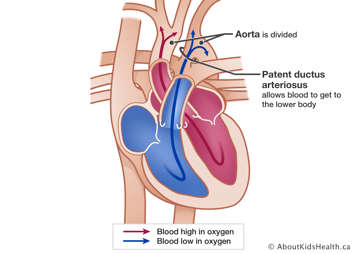Interrupted aortic arch is a defect that results when the aorta does not develop properly. With this condition, oxygen-rich blood from the left side of the heart cannot reach all areas of the body because of the defective aorta. The heart manages to get enough blood to the body by way of the ductus arteriosus, which has stayed open after birth. It usually occurs with a large atrial or ventricular septal defect.


What are the symptoms of interrupted aortic arch?
A child with this condition will develop symptoms as the ductus arteriosus begins to close, and will require surgery during the first few days of life. Symptoms include weakness, poor feeding, fatigue, shortness of breath and laboured breathing, fast heart rate, and low oxygen levels. Congestive heart failure may also develop as part of this heart condition.
An electrocardiogram and an echocardiogram will be done to diagnose this defect.
How is interrupted aortic arch treated?
At first, a drug like prostaglandin will be given to keep the ductus arteriosus open to improve blood flow. Open heart surgery within the first few days of life will be done to correct the defect. This will involve connecting the two separate pieces of the aorta, closing the PDA, and closing the ASD or VSD.
What is the long-term outlook for children with interrupted aortic arch?
Complete repair of the defect results in about a 90% survival rate for children with interrupted aortic arch.
